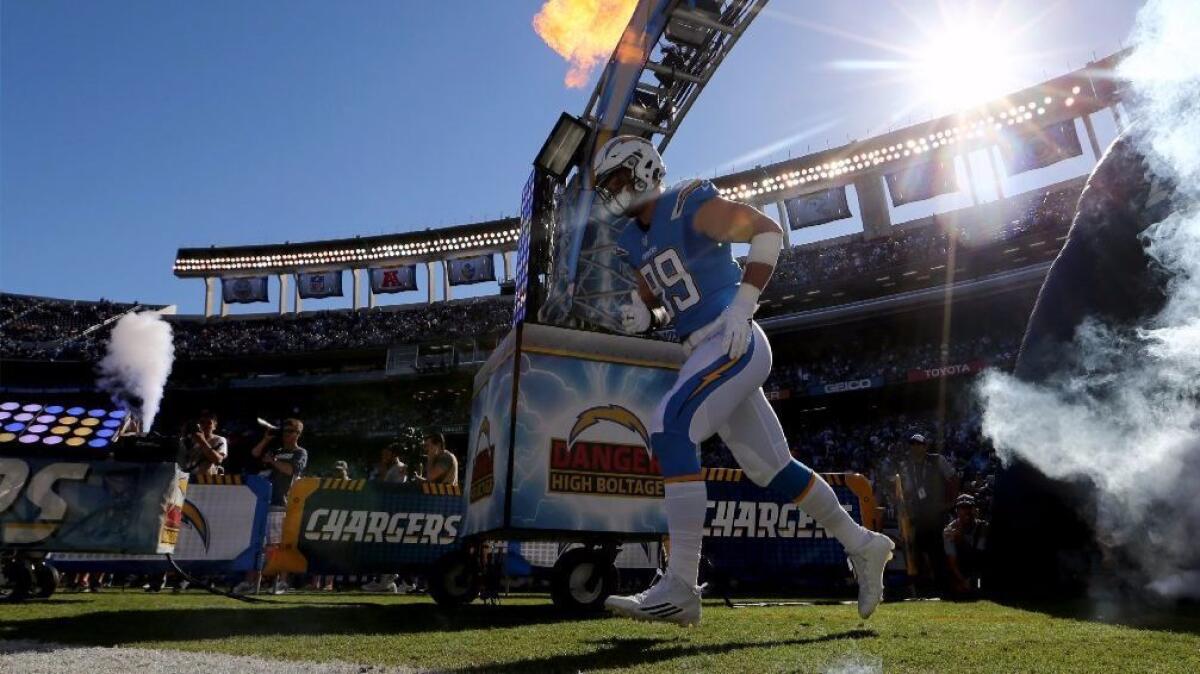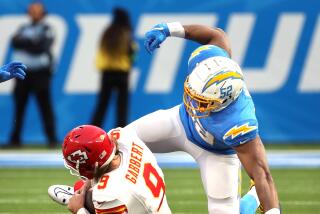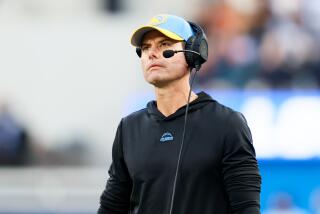Stadium measures for Chargers in San Diego losing badly

Two ballot measures that could have brought a combined convention center annex and Chargers stadium to downtown San Diego were trailing badly Tuesday in early returns.
The results could prompt the Chargers to exercise an option they have to relocate to Los Angeles, but the team may decide to search for another local stadium solution instead.
Measure C, which included a hotel-tax increase sponsored by the Chargers, was getting support from 39 percent of voters, far short of the 66.7 percent needed for approval.
Measure D, which also had a hotel-tax increase and was placed on the ballot by environmentalists and other community leaders, was getting support from 40 percent, also well short of a two-thirds majority.
Getting support from less than 50 percent of voters would eliminate opportunities either measure could have had to transform failure to success through the legal system.
The state Supreme Court’s ruling in California Cannabis Coalition v. City of Upland could reduce the approval threshold for measures placed on the ballot by citizen’s initiative from two-thirds to a simple majority.
Measure D co-author Cory Briggs had said he would file suit on different grounds than that case if Measure D got support from a simple majority, contending his measure doesn’t need two-thirds approval because it’s a general tax, not a tax for a specific purpose.
But both measures appeared highly unlikely to reach 50 percent approval, based on the early returns.
The Chargers didn’t immediately comment on the early returns, but Chargers owner Dean Spanos said in September that how close Measure C came to passing could play a key role in his decision how to move forward.
The team has until Jan. 15 to exercise an option to move to Los Angeles and join the Rams in a stadium being constructed in Inglewood.
“I think percentage tells me a lot,” Spanos said in September. “If we only get 30 or 35 percent that tells you one thing. If we get 60 percent that tells you something else. I’m anxious to see what’s going to happen on Nov. 8.”
Spanos left open the possibility that if Measure C failed, he would negotiate a different deal with Mayor Kevin Faulconer or possibly explore other sites in San Diego County outside the city.
But Spanos said he wouldn’t consider pursuing a new stadium in Mission Valley, where the team plays now in aging Qualcomm Stadium, because it wouldn’t make financial sense for the city or the team to build a stand-alone stadium there.
He said such a stadium would host eight to 10 events per year, while the team’s proposal for downtown includes a convention center annex, making it active an estimated 300 days per year.
The Supreme Court case is still a ray of hope for the Chargers, because a ruling in the team’s favor would reduce the approval threshold for a subsequent stadium measure to a simple majority.
The team filed a brief in the case last week, arguing that California’s constitution grants unique power to citizens that should include a lower approval threshold for tax measures by initiative.
The failure of Measure C comes despite the Chargers spending millions on TV and radio commercials and launching a strong ground campaign including volunteers and paid professionals knocking on doors throughout San Diego.
Measure C was endorsed by Mayor Faulconer and the San Diego Regional Chamber or Commerce, but was opposed by the powerful hotel industry and most other San Diego elected leaders.
The mayor’s endorsement came after the team agreed to a series of concessions that weren’t legally binding, which could have made voters skeptical.
Opponents said Measure C was fraught with a variety of risks for taxpayers and local tourism, including possibly prompting Comic-Con International to leave town.
They also said the Chargers were underestimating construction costs, called the measure a giveaway to a billionaire NFL owner and questioned the Chargers claims that Measure C would boost the local economy.
The failure of Measures C and D is just the latest in a series of setbacks for the Chargers 15-year-long pursuit of a replacement for Qualcomm Stadium.
The team’s previous efforts have included exploring a new stadium on the Qualcomm site that would have been partly funded by building condos there, and then meeting with officials in National City, Chula Vista, Oceanside and Escondido about possibly building stadiums in those cities.
The Chargers unveiled Measure C last spring, shortly after the NFL granted the team an option in January to join the Rams in Inglewood.
The Chargers quickly negotiated a tentative deal with Rams owner Stan Kroenke to share the Inglewood stadium, but then announced they would stay in San Diego for the 2016 season and pursue a local stadium solution.
NFL owners chose the Rams proposed Inglewood stadium over a rival stadium the Chargers and the Oakland Raiders had proposed in the Los Angeles suburb of Carson.
Both Measure C and Measure D would have increased local hotel taxes to pay for a combined convention center annex and stadium next to Petco Park in downtown’s East Village.
Measure C would have increased the local hotel taxes from 12.5 percent to 16.5 percent, while Measure D would have hiked them to 15.5 percent.
Under Measure C, the Chargers would have contributed $650 million for the stadium portion of the project, using $300 million from the NFL and $350 million from the team, licensing payments, sales of “stadium-builder” ticket options to fans, and other private sources.
The city would have raised $1.15 billion by selling bonds that would be paid back with the higher hotel tax revenues. That $1.15 billion would cover the city’s $350 million contribution to building the football stadium, $600 million to build the adjoining convention center annex, and $200 million for land.
Under Measure D, the only public subsidy to the Chargers would have been land. Hoteliers could have used some of the higher hotel taxes to pay for the convention center annex, with the Chargers and the NFL paying for the stadium portion of the project.
Measure D would also have allowed the Mission Valley stadium site become a park, a San Diego River interpretive center and a higher education annex.
That would have prevented the site from being developed with any of the proposals of the past for intense projects including office buildings, condos or retail shops.
Measure D supporters didn’t mount much of a campaign, primarily because they spent more than expected gathering signatures to qualify it for the ballot.
The San Diego County Taxpayers Association, with funding from the local hotel industry, mounted a campaign against both Measures C and D in the final days before the election.
The Chargers and the authors of Measure D explored combining the two measures into one last spring, but couldn’t reach a compromise.
ALSO
Lakers’ winning streak comes to an end in 109-97 loss to Mavericks
Jamal Crawford scales a Hill and keeps climbing up the all-time NBA scoring list
Right now, Angels have four established starting pitchers
More to Read
Get our high school sports newsletter
Prep Rally is devoted to the SoCal high school sports experience, bringing you scores, stories and a behind-the-scenes look at what makes prep sports so popular.
You may occasionally receive promotional content from the Los Angeles Times.






